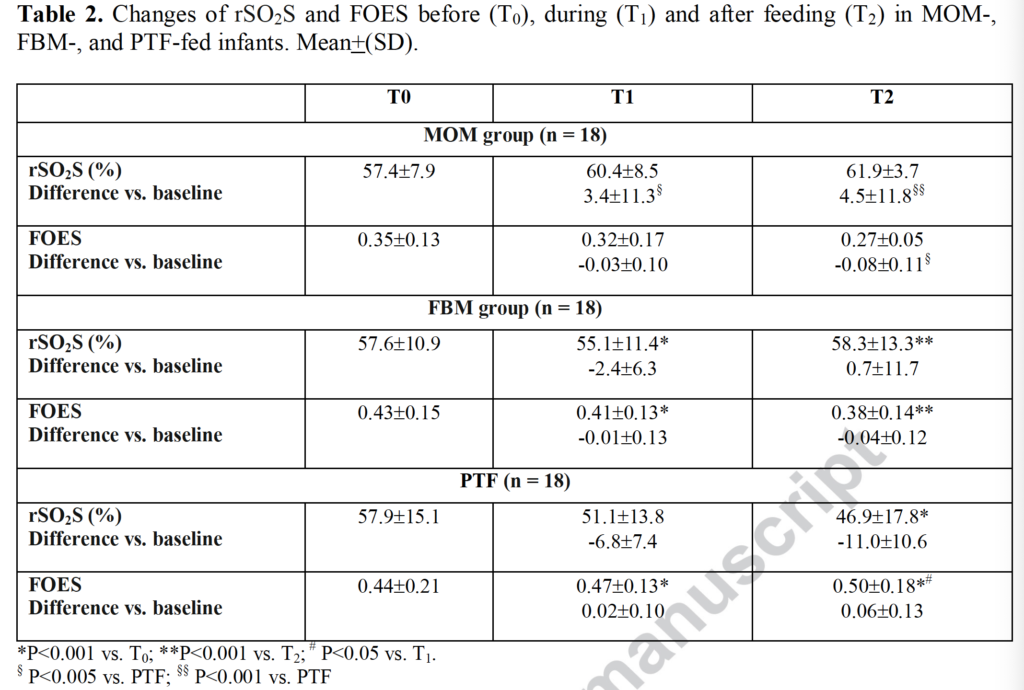It seems so simple doesn’t it. Shouldn’t we just be able to feed milk whether it be from humans or cows and our preemies will just adapt? I have often written about human milk diets vs those with bovine but this week an intriguing article came my way that really gave me some pause to say hmmm. Human milk diets have been shown to reduce the risk of necrotizing enterocolitis (NEC) compared to use of formula. The use of bovine human milk fortifiers falls somewhere in the middle I suppose as the diet in that case is mostly human milk with some bovine sprinkled in so to speak. If NEC is something that these infants are at increased risk of then what might be going at a tissue level when infants are exposed to human milk alone vs other bovine ingestions?
Near Infrared Spectroscopy May Tell Us the Answer
Dani C et from Italy just published an elegant study entitled EFFECT ON SPLANCHNIC OXYGENATION OF BREAST MILK, FORTIFIED BREASTMILK, AND FORMULA MILK IN PRETERM INFANTS. The study looked at the use of two particular measurements from regional splanchnic NIRS application. One is called splanchnic regional oxygenation (rSO2S) and the other splanchnic fractional oxygen extraction ratio (FOES). The rSO2S tells you how much oxygen is in the gut at a tissue level and FOES which is calculated by using systemic oxygenation (SpO2) using the formula (SpO2-rSO2S)/SpO2). So FOES will be high when rSO2S is low meaning the gut relative to the rest of the body is consuming more oxygen. For this study, increments in feedings were standardized for all infants. The study was done once patients were on full bolus feedings for one week.
The authors designed a study that needed 15 infants in three different groups with the first being human milk, then human milk + bovine fortifier and then the last formula fed infants. NIRS data was recorded 30 minutes before a feed (T0), 30 minutes after a bolus feed (T1) and then 2 hours after a bolus feed (T2). In the end the authors recruited 18 per arm. What the authors found is what I am having trouble not running with in terms of its meaning.

Looking at the data, babies who were fed exclusively mothers own milk experienced no change at all in rSO2S at any time points. Interestingly the value even trended higher after a feed. Infants who received fortified human milk experienced a decrease in this value from before the feed to 30 minutes afterwards but then recovered by 2 hours. Formula fed infants though simply dropped from exposure to formula after 30 minutes through 2 hours and the FOES rose over that time demonstrating a greater amount of oxygen extraction by the gut.
What is the meaning of all this?
Bovine sources of nutrition in the form of fortifier seem to cause the gut to become more metabolically active and consume more oxygen at least for the first 30 minutes after a feeding. Formula tends to have a progressive increase in oxygen extraction over the first two hours post feed. This may be reflective of stress in the gut as it works harder to absorb and process nutrients from a bovine source and perhaps in a dose response fashion, a little bovine content as in fortifier causes some short term increase in oxygen demand vs pure bovine formula causing a sustained increase in oxygen need.
This situation sets up an interesting concept. The NIRS results if you recall are from babies who have reached full feeds for one week. What if these same studies had been done in babies who were just in the process of increasing feeds? If infants consuming bovine sources of nutrition need more oxygen in the gut, might this explain why in the presence of acidosis, congenital heart defects or even with a PDA causing changes in end diastolic flow that they don’t tolerate in many cases anything other than human milk?
I am not aware of any such studies looking at feeding advancement but it does really make me wonder what we would see as we advance feedings using our protocols? It is tempting to place abdominal NIRS sensors on the bellies of preterm infants who are just starting out on HMF and see what happens? If the rSO2S was going down and/or the FOES was rising, would you stop the bovine fortification if it reached a certain point? What would happen if a human milk fortifier was used instead of a bovine source? Any difference?
So many questions and in my mind a great area for research. I can’t wait to see where this all goes.


What about using zhMF and Bennyprotein together, does anyone use this combo or had problems using it?
In simplistic terms, inflammation which is a natural healing response to tissue damage, causes increased blood flow and therefore requires more oxygen and energy to repair the damaged tissue. Bovine based formula is known to be inflammatory for newborns.